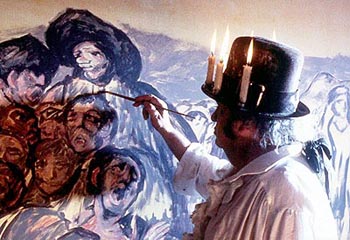![[Metroactive Movies]](http://metroactive.com/movies/gifs/movies468.gif)
[ Movies Index | Show Times | San Jose | Metroactive Central | Archives ]
Painting the Past
Carlos Saura paints a portrait of the artist as an old man in 'Goya'
By Richard von Busack
VERY MUCH an old man's movie, Goya in Bordeaux is the vegetating, slow and repetitive story of Francisco de Goya as an 80-year-old in comfortable exile in the south of France during the 1820s. Paco Rabal plays the artist as big-bellied, decrepit and, of course, deaf. Carlos Saura, who directs, is helped out by the photography of Vittorio Storaro in reproducing the colors of Goya's paintings. Goya in Bordeaux reduces a prodigious career to the familiar incidents of a great artist's life as told by the movies. He's pestered by hallucinations, soothed by his chiding but loving woman (Eulalia Ramon) and haunted by the one real love of his life, who, as a ghost, is trying to lure him into Deadland.
Saura presumes that the Duchess of Alba was the one real love of Goya's life. The duchess may have been the artist's lover, and she was painted by him as La Maja Desnuda. The 1959 film The Naked Maja, which also postulated this story, was pretty much understood as the corny old-movie motif of the haughty duchess and a rough-hewn courtier. Here it is again. Though Saura's film tells us that the duchess was a brilliant woman, we mostly see her on her back, kittenish and spoiled. (Maribel Verdú is an angular, handsome performer, but she bears only the slightest resemblance to Alba).
Goya in Bordeaux also focuses on the artist's deep regrets at being a court painter, and in his reveries, the old man offers many apologies for his life. Regrets? I'd thought he'd revenged himself thoroughly upon the royal inbreds he painted--boiling them in oil paint. His portraits of the different freakish creatures who held the throne of Spain look as if someone had gathered the loiterers at a West Virginia Greyhound station, decked them out in gold and jewels and used them for models. Goya even signed his name on the collar of the royal dog in one of the portraits: I suspect he was in on the joke.
The film looks staged and would probably work better as live theater. The use of transparent walls and backdrops increases the artificiality, which, Saura proposes, is Goya's legacy as a painter. The film ends with a quote by Andre Malraux: "After Goya, modern painting begins." But this erstwhile modernist bio film, weaving back in forth randomly in time, gives us nothing but familiar dioramas and scenes. As might be anticipated, for its finale, Goya in Bordeaux presents us with re-enacted scenes from the artist's engravings Horrors of War, atrocities he witnessed during the brutal guerrilla war between the Spanish forces and Napoleon's army. Watching these tableaux of corpses, dead trees, dogs and howling wind, I started to get moist-eyed. Then I realizing that what was moving me wasn't the movie but the memory of seeing Horrors of War exhibited at the Norton Simon Museum in Pasadena, decades ago. The power of this film comes directly from the power of Goya's art; it evinces no similar power to reflect it.
[ San Jose | Metroactive Central | Archives ]
Copyright © 2000 Metro Publishing Inc. Metroactive is affiliated with the Boulevards Network.
For more information about the San Jose/Silicon Valley area, visit sanjose.com.
![]()

Flame Is Fleeting: Goya (Francisco Rabal) works by candlelight in 'Goya in Bordeaux.'
Goya in Bordeaux (R; 102 min.), directed and written by Carlos Saura, photographed by Vittorio Storaro and starring Francisco Rabal, Maribel Verdú, opens Friday at Camera 3 in San Jose and at the Guild in Menlo Park.
From the September 28-October 4, 2000 issue of Metro, Silicon Valley's Weekly Newspaper.